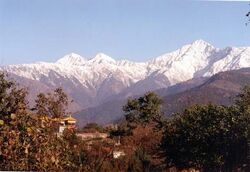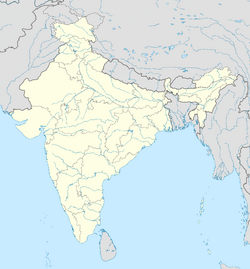| ||||||||||||||
| Kangra district काँगड़ा ज़िला |
|
|---|---|
| — district — | |
| Location in Himachal Pradesh, India | |
| Coordinates: Coordinates: | |
| Country | |
| State | Himachal Pradesh |
| Talukas | Kangra
Nurpur Jawali Indora Dehra Shahpur Baroh Khundian Jaswan Rakkar Fatehpur Baijnath Jaisinghpur Dharamshala Palampur |
| Headquarters | Dharamshala |
| Government | |
| • Deputy Commissioner | Ram Swarup Gupta, IAS |
| • Superintendent of Police | Atul Kumar Digamber Fulzele |
| Area | |
| • Total | 5,739 km2 (2,216 sq mi) |
| Population (2001) | |
| • Total | 13,39,030 |
| • Density | 233/km2 (600/sq mi) |
| Languages | |
| • Official | Hindi |
| Time zone | IST (UTC+5:30) |
| PIN | 176xxx |
| Telephone | 91 1892 xxxxxx |
| Largest city | Palampur |
| Climate | ETh (Köppen) |
| Avg. summer temperature | 32 °C (90 °F) |
| Avg. winter temperature | 20 °C (68 °F) |
| Website | hpkangra.nic.in |
Kangra is the most populous[1] district of the state of Himachal Pradesh, India. Dharamshala is the administrative headquarters of the district.
Geography[]
The Kangra District of Himachal Pradesh is situated in the Western Himalayas between 31°2 to 32°5 N and 75° to 77°45 E. The district has a geographical area of 5,739 km. which constitutes 10.31% of the geographical area of the State. According to 2001 census, the total population of the district was 13,39,030, which is the highest in the state (22.50% of the population). The altitude of the district ranges from 427 to 6401m above mean sea level, with the lowest being in the plains areas bordering Gurdaspur district of Punjab in the west and Una district of H.P. in the south. In the east, it borders Mandi district, in North with Kullu and Chamba. The district has considerable diversity in its soils, physiography, land use patterns and cropping systems. On the basis of these, the district has further been divided into five sub-regions i.e. Pir Panjal, Dhauladhar, Kangra Shiwalik, Kangra Valley and Beas Basin.
The Beas is one of the larger rivers of this district, and contributes to the fertility of the land here. The district is bounded by the Himachal Pradesh districts of Chamba to the north, Lahul and Spiti to the northeast, Kullu to the east, Mandi to the southeast, and Hamirpur and Una to the south. The district shares a border with the states of Punjab on the southwest, and Jammu and Kashmir on the northwest. Due to the hilly terrain, not very much of the land is cultivated. The region is covered with uniform patches of barren land, as well as small forests.There is a reasonably good network of roads across the district.
Dharamshala, the district headquarters, is also the headquarters of the Tibetan government-in-exile, headed by the His Holiness the Dalai Lama. Jwalamukhi, also known as Jwala ji, is famous for its ancient temple of the goddess of the same name, and features holy flames that run on natural gas. Other important temples include Brajeshwari Devi temple, Chamunda Devi temple, Chintpurni temple, Bhagsunag Temple in McLeodGanj and Baijnath's Shiva temple. There are also important Buddhist temples in Dharamshala, Sidhbari and the Bir Tibetan Colony in Bir. Historical villages of Pragpur and Garli are also located here.
Masroor Temple (also known as the 'Ajanta Ellora of Himachal Pradesh') is the only rock-cut temple in north India, believed to be built by the Pandavas during their exile period.
Climate[]
The topography of Kangra District is varied, with elevations ranging from 400m altitude at Milawan to 5500m at Bara Bhangal. The Indora block of Kangra District lies in a semi-humid, sub-tropical zone where annual precipitation averages approximately 1000mm with a mean temperature of about 24°C, Dehragopipur and Nurpur blocks lies in a humid, sub-tropical zone where the annual rainfall is between 900–2350mm and mean temperature ranging between 2° and 24°C. Palampur and Dharamshala lie in a wet, temperate zone where the temperature ranges from 15 to 19°C and annual rainfall is about 2500mm, making Dharamshala the wettest place in Himachal Pradesh. (avg. of the last fifty five years). Other parts of the Kangra district lie in hill areas where the mean annual temperature varies from 13 to 20°C and annual rainfall is 1800– 3000mm.
The winter lasts from mid-December to mid-February, during which the temperature ranges from 0 to 20 °C. The winds cause winter rains. Summers last from April until June, and are hot (temp 25 to 38 °C) and dry. They are generally followed by a wet monsoon which ends in autumn.The climate in the region is cool and soothing, especially near the Chamundaji sub-region, due to the presence of many pine trees. Due to deforestation in the name of development, however, the clean and serene environment of the region may be threatened. The need of the hour is to plant more trees and to safeguard existing trees.[2] A tree-planting program in Kangra District has been initiated by Dharmalaya Institute in Bir.[3]
| Climate data for Dharamshala | |||||||||||||
|---|---|---|---|---|---|---|---|---|---|---|---|---|---|
| Month | Jan | Feb | Mar | Apr | May | Jun | Jul | Aug | Sep | Oct | Nov | Dec | Year |
| Average high °C (°F) | 13.5 (56.3) |
17.8 (64.0) |
21.6 (70.9) |
26.9 (80.4) |
29.1 (84.4) |
30.5 (86.9) |
27.2 (81.0) |
26.1 (79.0) |
24.6 (76.3) |
23.7 (74.7) |
19.8 (67.6) |
16.4 (61.5) |
23.1 (73.6) |
| Average low °C (°F) | 5.1 (41.2) |
10.3 (50.5) |
14.7 (58.5) |
16.3 (61.3) |
20.1 (68.2) |
22.9 (73.2) |
21.4 (70.5) |
20.2 (68.4) |
17.5 (63.5) |
14.8 (58.6) |
10.7 (51.3) |
7.4 (45.3) |
15.1 (59.2) |
| Precipitation mm (inches) | 114.5 (4.508) |
100.7 (3.965) |
98.8 (3.89) |
48.6 (1.913) |
59.1 (2.327) |
202.7 (7.98) |
959.7 (37.783) |
909.2 (35.795) |
404.8 (15.937) |
66.3 (2.61) |
16.7 (0.657) |
54.0 (2.126) |
3,054.4 (120.252) |
| Source: http://www.bbc.co.uk/weather/world/city_guides/results.shtml?tt=TT004930 | |||||||||||||
Demographics[]
According to the 2011 census Kangra district has a population of 1,507,223,[1] roughly equal to the nation of Gabon[4] or the US state of Hawaii.[5] This gives it a ranking of 331st in India (out of a total of 640).[1] The district has a population density of 263 inhabitants per square kilometre (680 /sq mi) .[1] Its population growth rate over the decade 2001-2011 was 12.56 %.[1] Kangra has a sex ratio of 1013 females for every 1000 males,[1] and a literacy rate of 86.49 %.[1]
The native people are the Kangri people and the native language is Kangri, which is very similar to Punjabi. The majority of the people are Hindu Gurjar , Rajputs and , although many Tibetans and others who follow Buddhism have also settled here recently. There are also minority populations of Sikhs, Muslims, and Christians.
The traditional dress for men was the kurta, pyjamas, and a woolen jacket used in winter. Women generally wear the salwar kameez and with the salwar Kameez girls and women take chuenni ("Chaddru" in local language.)
General information[]
- Sub divisions in Kangra: Kangra, Palampur, Dharamshala, Nurpur, Dehra Gopipur, Baijnath, Jwali and Jaisinghpur.
- Tehsils in Kangra: Nurpur, Indora, Jwali, Kangra, Palampur, Badoh, Kasba Kotla, Jaswan, Dehra Gopipur, Khundiyan, Jaisinghpur, Baijnath, Fatehpur, Dharamshala and Shahpur.
- Sub-Tehsils in Kangra: Harchakkian, Dhira, Rakkad, Thural and Meerthan.
Economy[]
The Economy of Kangra District consists mostly of agriculture and farming. Tea cultivation plays a vital in the economy. "Kangra Tea" is famous worldwide for its rich aroma and taste. A few other industries that have been established in the region, including water packaging, construction materials, and potato chips.
The towns of Palampur and Bir are surrounded by lush, green tea estates. Tourism is also an important part of the economy, with Bir in particular becoming a strong hub for ecotourism.[6]
History[]
Kangra is known for having the oldest serving Royal Dynasty in the world Katoch.{Cn} Kangra became a district of British India in 1846, when it was ceded to British India at the conclusion of the First Anglo-Sikh War. The British district included the present-day districts of Kangra, Hamirpur, Kullu, and Lahul and Spiti. Kangra District was part of the British province of Punjab. The administrative headquarters of the district were initially at Kangra, but were moved to Dharamshala in 1855.[7][8]
This area was significantly damaged by an earthquake on April 4, 1905.
Upon Indian Independence in 1947, Punjab province was partitioned between India and Pakistan, and the eastern portion, including Kangra, became the Indian state of Punjab. Lahul and Spiti became a separate district in 1960, and Kullu in 1962. In 1966, Kangra and Una districts were added to Himachal Pradesh, which became a Union territory of India, and an Indian state in 1971. Hamirpur District was separated from Kangra in 1972. The twin township and riyasat of Haripur-Guler is also an important part of Kangra District that gave refuge to people during the Mughal period and offered patronage to them to make the famous Guler paintings. The village of Pragpur is also one of the most important historical part of Kangra region.
See also[]
- Kangra Valley
- Kangra Valley Railway
- Kangra Fort
- Kangra photo gallery
References[]
- ^ a b c d e f g "District Census 2011". Census2011.co.in. 2011. http://www.census2011.co.in/district.php. Retrieved 2011-09-30.
- ^ [1]
- ^ http://dharmalaya.in/earthville-orchards/
- ^ US Directorate of Intelligence. "Country Comparison:Population". https://www.cia.gov/library/publications/the-world-factbook/rankorder/2119rank.html. Retrieved 2011-10-01. "Gabon 1,576,665"
- ^ "2010 Resident Population Data". U. S. Census Bureau. http://2010.census.gov/2010census/data/apportionment-pop-text.php. Retrieved 2011-09-30. "Hawaii 1,360,301"
- ^ http://birhp.com/
- ^ Kangra District The Imperial Gazetteer of India, v. 14, p. 380. .
- ^ Dharamshala The Imperial Gazetteer of India, v. 11, p. 301.
Further reading[]
- Hutchinson, J. & J. PH Vogel (1933). History of the Panjab Hill States, Vol. I. 1st edition: Govt. Printing, Pujab, Lahore, 1933. Reprint 2000. Department of Language and Culture, Himachal Pradesh. Chapter V Kangra State, pp. 99–198.
External links[]
- Kangra District, Official website
- Distt Profile
- Kangra's History
- Temples of Kangra
- Kangra Map
- Kangra photo gallery

|
Gurdaspur district, Punjab | Chamba district | Lahaul and Spiti district | 
|
| Kullu district | ||||
 Kangra district | ||||
| Hoshiarpur district, Punjab | Una district | Mandi district Hamirpur district |
| |||||
| Lakes | Renuka Lake | Maharana Pratap Sagar | Gobind Sagar (more...) |
|---|---|
| Rivers | Beas | Chenab | Ravi | Sutlej | Yamuna |
| Districts | Bilaspur | Chamba | Hamirpur | Kangra | Kinnaur | Kullu | Lahul and Spiti | Mandi | Sirmaur | Shimla | Solan | Una |
| Other | Climate of Himachal Pradesh | Protected areas of Himachal Pradesh | List of peaks in Himachal Pradesh |
| This page uses content from the English language Wikipedia. The original content was at Kangra district. The list of authors can be seen in the page history. As with this Familypedia wiki, the content of Wikipedia is available under the Creative Commons License. |



